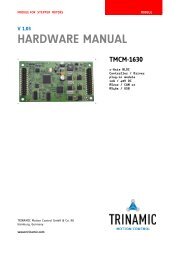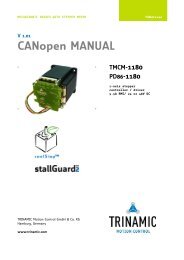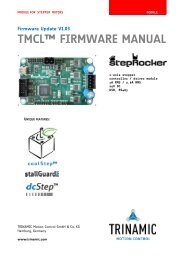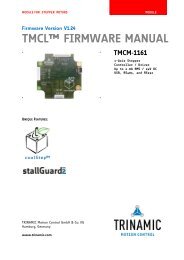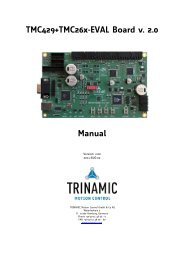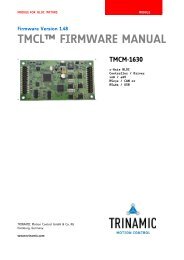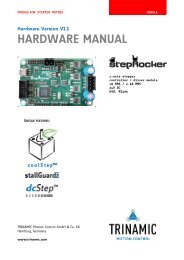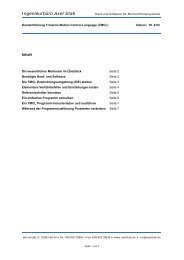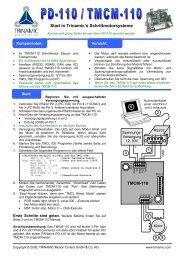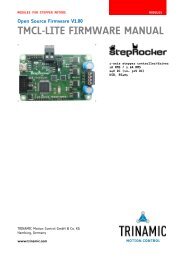TMC428 – Application Note - Trinamic
TMC428 – Application Note - Trinamic
TMC428 – Application Note - Trinamic
Create successful ePaper yourself
Turn your PDF publications into a flip-book with our unique Google optimized e-Paper software.
<strong>TMC428</strong> <strong>–</strong> <strong>Application</strong> <strong>Note</strong> <strong>–</strong> <strong>TMC428</strong> Getting Started <strong>–</strong> Including StallGuard TM 13<br />
(v. 2.00 / April 14, 2008)<br />
4. StallGuard Profiler<br />
StallGuard is primarily intended for noiseless reference search with a mechanical reference position.<br />
How well StallGuard works primarily depends on three constrains from the stepper motor and its<br />
application:<br />
efficiency of a stepper motor in terms of mechanical power vs. power dissipation<br />
difference in mechanical load between free running and stall on barrier<br />
velocity of the stepper motor<br />
If a given stepper motor and its application fit well to StallGuard, the optimal velocity has to be<br />
determined for StallGuard. Generally, there is not only one optimal velocity for StallGuard. There are<br />
ranges of velocities that are sufficient for StallGuard.<br />
The goal of a StallGuard profiler is to determine the ranges of velocities that fit well for the sensorless<br />
stall detection. Each velocity of a given stepper motor is associated with an individual StallGuard level.<br />
Mechanical load <strong>–</strong> as occurs on a stall <strong>–</strong> changes the StallGuard level.<br />
There are two kinds of StallGuard profilers: One for continuous motion and one for motion within a<br />
limited range of motion.<br />
Because StallGuard is able to sense oscillations of the rotor, after acceleration it is necessary to wait a<br />
while until the StallGuard load indicator are valid to detect a stall.<br />
So, first one has to accelerate to the velocity that is to be profiled. When the acceleration phase is<br />
finished, one has to wait a while (typical 100 ms for a free running stepper motor) before processing of<br />
the StallGuard load indicator bits. Then one measures n (e.g. n=10 ) times the value of the load<br />
indicator bits an calculates and calculates the mean value and the standard deviation for each velocity.<br />
The resolution of StallGuard concerning detection of a mechanical reference point is one full step.<br />
4.1 StallGuard Demo <strong>–</strong> Source Code Example<br />
A source code example of a StallGuard demonstration (routine tmc428_stallguard_demo(…)) is<br />
part of the tmc428demo.zip (pls. refer „tmc428_misc.c). The parameters are<br />
sm : stepper motor (0, 1, 2)<br />
vmax : velocity of the stepper motor number sm<br />
sgl : StallGuard level (0, 1, 2, 3, 4, 5, 6, 7)<br />
The read StallGuard values (load indicator bit vectors ld) are continuously printed on the console. If a<br />
stall is detected (ld < sgl) it additionally prints “StallGuard @ x_actual” where x_actual is the actual<br />
position where a stall has been detected. Other parameters (a_max, …) are use as they currently set.<br />
Copyright © 2005-2008 TRINAMIC Motion Control GmbH & Co. KG



